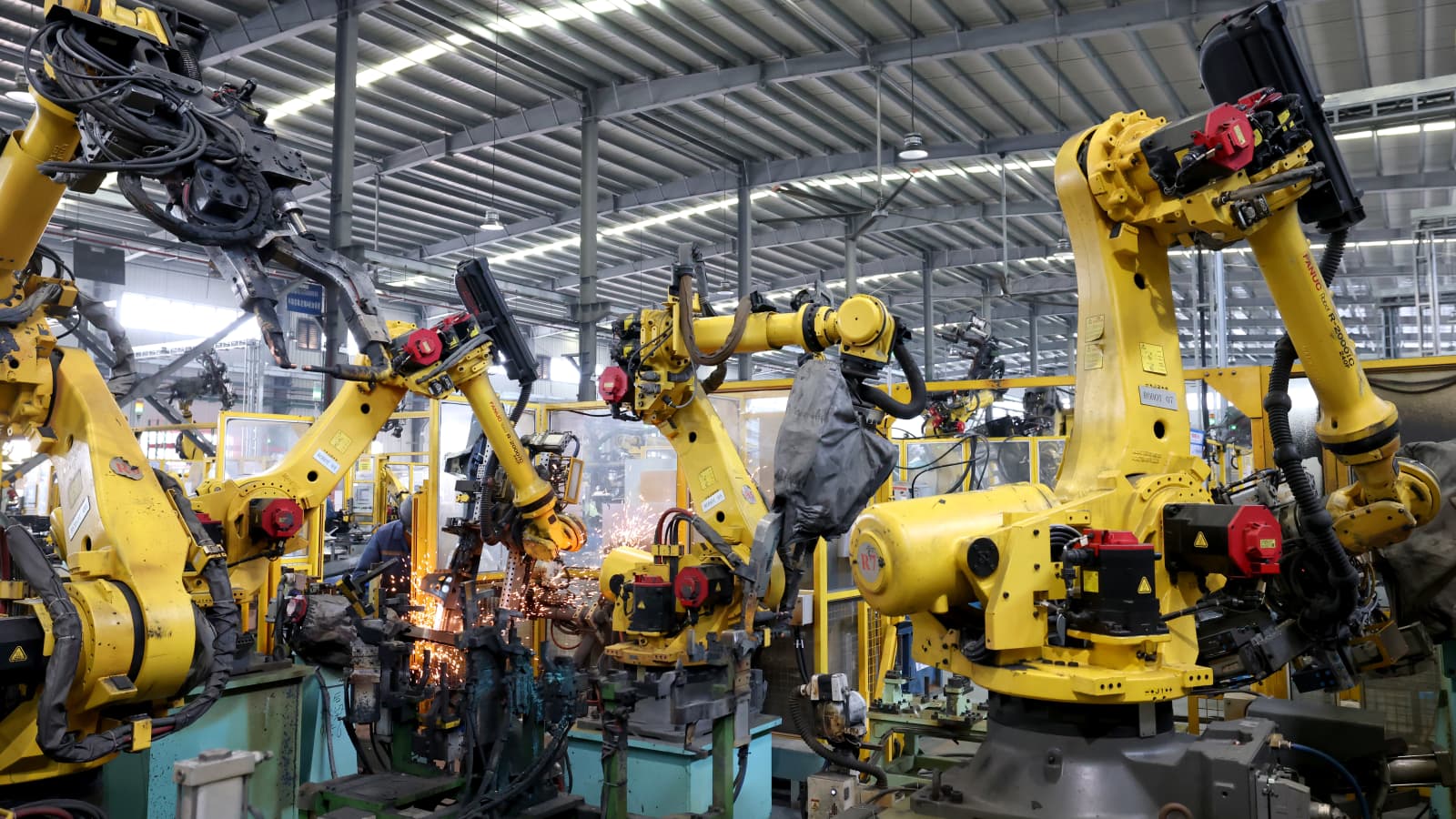China’s Factory Growth Cools in October as Export Orders Drop Sharply
China’s Factory Growth Cools in October as Export Orders Drop Sharply
By
Leah Rosenfeld
Last updated:
November 3, 2025
First Published:
November 3, 2025

Robots manufacture auto parts at a factory in Ningde, China, on Oct. 17, 2024. | Nurphoto | Nurphoto | Getty Images
China’s factory activity lost steam in October, missing market expectations as new export orders plunged to their lowest level since May. The slowdown underscores growing pressure on the country’s manufacturing sector as global demand cools and trade friction with the United States resurfaces.
According to a private survey released Monday, the RatingDog China General Manufacturing PMI, compiled by S&P Global, slipped to 50.6 in October from 51.2 in September — below analysts’ forecasts of 50.9, based on a Reuters poll. Although the index remains above the 50-point threshold separating expansion from contraction, the decline reflects mounting challenges for Chinese manufacturers heading into the final quarter of the year.
Export Orders Fall to a Five-Month Low
The survey revealed that new export orders fell at the fastest pace since May, driven by what respondents described as “rising trade uncertainty.” The renewed tension between Beijing and Washington has weighed on export confidence, with businesses becoming increasingly cautious about new overseas commitments.
Despite a softer global demand environment, overall factory output and new business continued to grow, albeit at a slower rate compared to September. Business confidence, however, slipped to its weakest level in six months, suggesting firms are bracing for a potentially challenging end to the year.
Employment Shows Early Signs of Improvement
One positive takeaway came from the employment index, which expanded for the first time since March, reaching its highest level since August 2023. Manufacturers have begun modest hiring amid expectations of a trade recovery following diplomatic progress between the U.S. and China.
Private vs. Official PMI Data
The private PMI reading stood in contrast to the official manufacturing PMI, released by China’s National Bureau of Statistics last Friday, which fell to 49.0 — signaling the sharpest contraction in six months. Historically, private surveys such as those from RatingDog (previously Caixin) and S&P Global have presented a more optimistic picture since they focus more on export-oriented small and medium enterprises rather than large state-owned firms.
The RatingDog PMI survey gathers responses from around 650 manufacturers, while the official PMI includes over 3,000 companies. Data for the private survey is collected during the second half of each month, giving it an early indication of evolving business sentiment.
Trade Truce Brings Short-Term Relief
The manufacturing slowdown came even as China and the United States reached a temporary trade truce last week after a high-level meeting between President Donald Trump and President Xi Jinping in South Korea. The agreement eased months of escalating trade tensions that had threatened to derail global supply chains.
Under the deal, the U.S. agreed to halve fentanyl-linked tariffs on Chinese goods to 10%, reducing the total tariff burden to about 47%, while China suspended its export restrictions on rare earth metals. Washington also paused its Section 301 investigation into China’s shipping and logistics sectors, while Beijing agreed to end anti-dumping probes targeting American chipmakers like Nvidia and Qualcomm.
China, in turn, will resume purchasing U.S. soybeans and energy products, signaling a gradual stabilization in trade relations.
Economic Outlook and Growth Forecasts
Despite the October slowdown, several economists remain cautiously optimistic about China’s medium-term outlook. Goldman Sachs recently upgraded its forecast for China’s GDP growth in 2025 to 5.0%, citing easing trade tensions and Beijing’s renewed focus on manufacturing competitiveness. The bank also expects 4.8% growth in 2026, reflecting improved export resilience and continued industrial upgrades.
So far this year, China’s exports have shown mixed performance. Shipments to the U.S. have declined by double digits year-over-year since April, but exports to Southeast Asia are up 14.7%, to the European Union by 8.2%, and to Africa by over 28%. Overall, exports rose 6.1% in the first three quarters of 2025, while imports fell 1.1%.
Domestic Economy Under Pressure
Domestically, however, signs of strain persist. China’s GDP grew 4.8% in the third quarter, its slowest pace in a year, as fixed-asset investment — including real estate — fell 0.5%, marking the first decline since 2020. Economists attribute this to waning stimulus effects, a prolonged property slump, and subdued consumer confidence.
According to Evercore ISI strategist Neo Wang, the strong base effect from last year’s fourth quarter, when GDP jumped 5.4% following a wave of stimulus, will make it harder for this year’s growth rate to maintain momentum. Wang added that fading government subsidies and continued weakness in housing could further drag on economic activity into next year.
The Road Ahead
While October’s PMI figures highlight a slowdown, analysts believe that the combination of trade easing, targeted stimulus, and resilient exports could help China’s manufacturing sector regain footing in the months ahead. The employment rebound offers a glimmer of hope that confidence may soon stabilize — but much will depend on how global demand and U.S.-China relations evolve heading into 2025.
Popular articles
Subscribe to unlock premium content
The Rise of Silent Walking Tours in Historic Cities

The Rise of Ultra-Niche Cooking Classes Focused on Historical or Regional Recipes

The Rise of One-Person Dining Experiences for Ultra-Introverts in Major Cities

The Rise of Silent Walking Tours in Historic Cities

The Rise of Ultra-Niche Cooking Classes Focused on Historical or Regional Recipes

The Rise of Silent Walking Tours in Historic Cities









